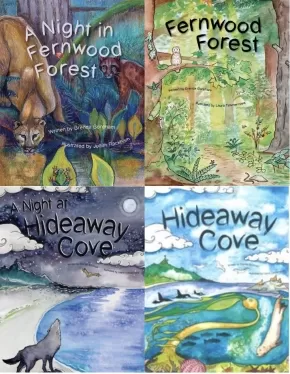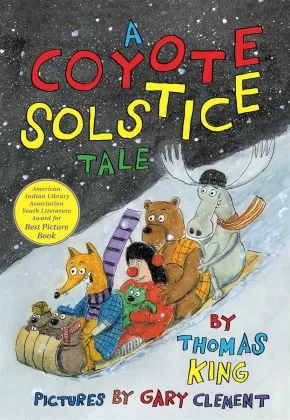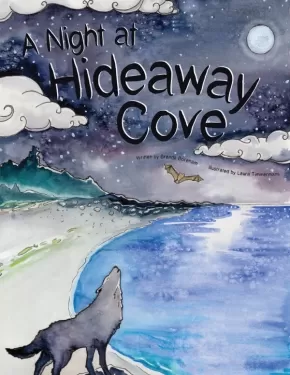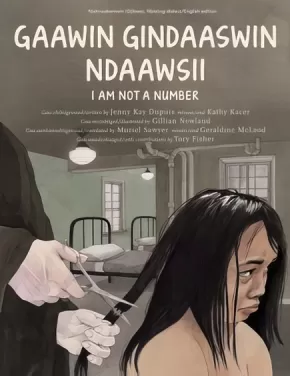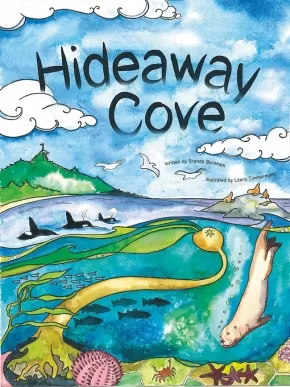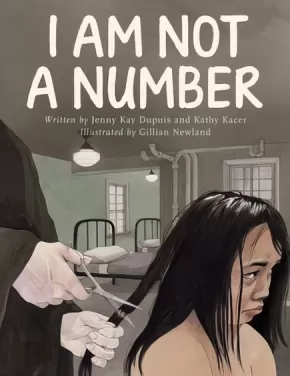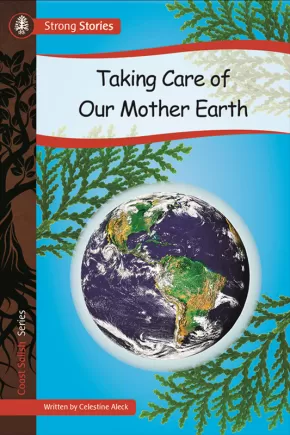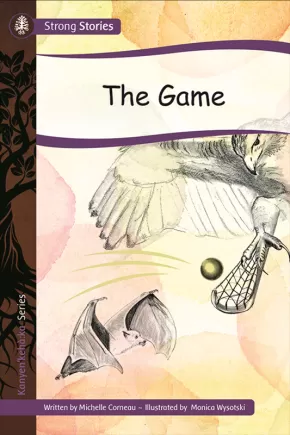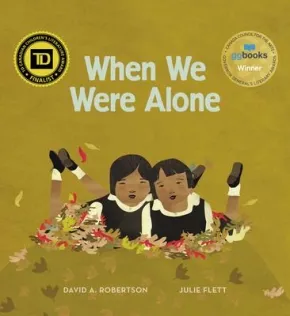
Reading Connections
1
-
15
of
58 Results;
Sort By
Go To
of 4
Welcome to Reading Connections!
Our thanks to Brenda Boreham for writing these fantastic lesson plans for Strong Nations!
Click on the SUB-CATEGORY to see each reading connection category. You will find several titles that have been selected to specifically to connect with teaching reading comprehension through the use of 6 learning strategies for both fiction and non-fiction. Some of the selected titles also include a free downloadable lesson plan.
Please visit our Educators page for more information.
Baseball Bats for Christmas
$24.99
Artists:
Format:
Hardcover
Text Content Territories:
Indigenous Canadian; Inuit;
ISBN / Barcode: 9781773219721
Synopsis:
Synopsis:
Celebrate the 35th anniversary of this beloved holiday classic with a fresh edition that preserves the magic of the original story and brings it to life with stunning new illustrations.
The year is 1955. Arvaarluk and his friends watch Rocky Parsons land his plane on the ice in Repulse Bay, a tiny community “smack dab on the Arctic Circle.” Having never seen trees before, the children try to guess what the six green spindly things are that Rocky delivers. One of the boys has a brilliant idea: why not use them as baseball bats?
Michael Arvaarluk Kusugak is one of Canada’s foremost storytellers. Baseball Bats for Christmas captures the warmth and cadence of his voice as he describes the close-knit life of his community and the ingenuity he and his friends demonstrated when faced with something wholly unfamiliar.
Award-winning Inuk illustrator Coco Apunnguaq Lynge draws inspiration from the iconic work of Inuk artist Germaine Arnaktauyok to immerse the reader in the beauty of the Arctic landscape.
Educator Information
Recommended for ages 5 to 8.
Themes: Inuit; Arctic; community; multicultural; friends; resourcefulness.
Additional Information
32 pages | 8.50" x 10.75" | Hardcover
A Night in Fernwood Forest
 $21.95
$21.95

Artists:
Format:
Hardcover
ISBN / Barcode: 9781771746021
Synopsis:
Synopsis:
Come with us for a walk along a secluded forest trail on a quiet night in May. We catch glimpses of ten animals as they move about in their woodland home from dusk until dawn. A mother cougar and her cub, a colony of bats, and a family of shrews are among the nighttime creatures we encounter. Beautiful full-page illustrations also depict many plants that live in this ecosystem. Information at the back of the book provides facts about nurse logs and the Pacific Northwest temperate rainforest.
A Night in Fernwood Forest is part of the By Day and By Night Nature Series. Books in this series focus on a specific habitat and explore the many connections within a healthy ecosystem. Through lyrical stories, supportive illustrations, labelled diagrams, and nature notes, readers learn about living and non-living parts of the ecosystem.
Additionally, readers can:
- use a picture clue on each page to predict the animal featured on the next page
- count animals as their numbers increase in each illustration
- search for an animal that travels from page to page
- discover patterns in the text and structure of each book
- track the movement of the sun or moon across the sky
Reviews
"Brenda Boreham brings her teaching experience and love of nature to these books, filling them with opportunities for the discovery of interactions between plants and animals in healthy ecosystems…. This beautiful book will engage listeners and independent readers and support the science goals in elementary school classrooms." – Canadian Teacher Magazine, Winter 2024 issue
Educator & Series Information
Recommended for kindergarten to grade 4.
This is a fictional story with factual information about the Pacific Northwest temperate rainforest.
Search for a moth that travels from page to page in this story!
Each book in the By Day and By Night Nature Series focuses on a scene typical of a distinct west coast habitat, showing how living and non-living things are connected in a healthy ecosystem. As readers, we observe animals going about their daily activities: caring for their young, searching for food, and responding to the changes in light, temperature, and weather conditions throughout the day or night. The last four pages of each book provide facts about the highlighted animals and plants as well as features that are unique to their habitats. The final page suggests ways that young readers and their families can be respectful as they visit wilderness areas.
Readers with a sense of curiosity will find opportunities in these books to:
- use picture clues to predict the featured animal on the next page
- identify, count, and sequence numbers (1 owl, 2 deer, 3 squirrels, etc.)
- search for small creatures that travel from page to page
- discover patterns in the text and structure of the books
- track the movement of the sun, or moon, across the sky
Curriculum Links
Reading - Providing opportunities for guided practise in using reading strategies: visualizing, making connections, asking questions, transforming, and inferring.
Science - Supporting discussion and further exploration:
- characteristics of living things
- needs of living things
- connections between living and non-living things
- daily and seasonal changes
- animal growth and changes
- plant growth and changes
- weather
- habitats
- observable patterns in the sky
Numeracy - Counting and sequencing of numbers 1 to 10.
Social Responsibility - Initiating discussions about ways to take care of wilderness areas.
Additional Information
32 Pages | 8.5" x 11" | Hardcover | ISBN: 9781771746021
32 Pages | 8.5" x 11" | Hardcover | ISBN: 9781771746021
By Day and By Night Nature Series Bundle
 $72.32 $80.35
$72.32 $80.35

ISBN / Barcode: 9781771746014
Synopsis:
Synopsis:
This bundle includes all four titles in the By Day and By Night Nature Series:
- Hideaway Cove (hardcover)
- A Night at Hideaway Cove (paperback)
- Fernwood Forest (hardcover)
- A Night in Fernwood Forest (hardcover)
Each book in the By Day and By Night Nature Series focuses on a scene typical of a distinct west coast habitat, showing how living and non-living things are connected in a healthy ecosystem. As readers, we observe animals going about their daily activities: caring for their young, searching for food, and responding to the changes in light, temperature, and weather conditions throughout the day or night. The last four pages of each book provide facts about the highlighted animals and plants as well as features that are unique to their habitats. The final page suggests ways that young readers and their families can be respectful as they visit wilderness areas.
Readers with a sense of curiosity will find opportunities in these books to:
- use picture clues to predict the featured animal on the next page
- identify, count, and sequence numbers (1 owl, 2 deer, 3 squirrels, etc.)
- search for small creatures that travel from page to page
- discover patterns in the text and structure of the books
- track the movement of the sun, or moon, across the sky
Reading Level: Nonfiction text features such as headings, bold words, bullets, captions, and labelled diagrams make these books accessible to independent readers in grades 2 to 4. The books would also be great “read-alouds” for younger children.
Curriculum Links
Reading - Providing opportunities for guided practise in using reading strategies: visualizing, making connections, asking questions, transforming, and inferring.
Science - Supporting discussion and further exploration:
- characteristics of living things
- needs of living things
- connections between living and non-living things
- daily and seasonal changes
- animal growth and changes
- plant growth and changes
- weather
- habitats
- observable patterns in the sky
Numeracy - Counting and sequencing of numbers 1 to 10.
Social Responsibility - Initiating discussions about ways to take care of wilderness areas.
Lesson plans are available for each book and are free to download from each book's listing on our website!
Additional Information
Titles included are 32 pages, 8.5" x 11"
Please note: All books in this bundle are hardcovers, except for A Night at Hideaway Cove, which is a paperback as the hardcover edition is out of print.
A Coyote Solstice Tale (PB)
$12.99
Artists:
Format:
Paperback
Text Content Territories:
Indigenous;
ISBN / Barcode: 9781773069128
Synopsis:
Synopsis:
Trickster Coyote is having his friends over for a festive solstice get-together in the woods when a little girl comes by unexpectedly. She leads the party-goers through the snowy woods to a shopping mall -- a place they have never seen before.
Coyote gleefully shops with abandon, only to discover that filling your shopping cart with goodies is not quite the same thing as actually paying for them. The trickster is tricked and goes back to his cabin in the woods -- somewhat subdued -- though nothing can keep Coyote down for long.
Awards
- Winner of the American Indian Library Association Youth Literature Awards, Best Picture Book
Reviews
"The humor is dry and affectionate, the rhyming text delights with sly turns of phrase, the watercolor cartoons are whimsical … [A] holiday treat." — School Library Journal
"This witty winter tale deftly skewers the materialistic aspect of the holiday season in a humorous, trenchant way." — Kirkus Reviews
Educator Information
Recommended Ages: 5 - 8.
Curriculum Connections: Social Studies, Geography, Physical Education and Health, Science.
Correlates to the Common Core State Standards in English Language Arts:
CCSS.ELA-LITERACY.RL.2.4
Describe how words and phrases (e.g., regular beats, alliteration, rhymes, repeated lines) supply rhythm and meaning in a story, poem, or song.
Additional Information
64 pages | 5.25" x 7.75" | Paperback
Fernwood Forest
 $21.95
$21.95

Artists:
Format:
Hardcover
ISBN / Barcode: 9781771745994
Synopsis:
Synopsis:
Join us on a bright, sunlit day in the middle of May as we wander the quiet trails of a secluded woodland. Here, we catch glimpses of the daily activities of many creatures—from a pair of black-tailed deer to a colony of carpenter ants—that make Fernwood Forest their home. We also learn about the three layers of the Pacific Northwest temperate rainforest and explore interesting facts about forest plants and animals.
Fernwood Forest is part of the By Day and By Night Nature Series. Books in this series focus on a specific habitat and explore the many connections within a healthy ecosystem. Through lyrical stories, supportive illustrations, labelled diagrams, and nature notes, readers learn about living and non-living parts of the ecosystem.
Additionally, readers can:
-
use a picture clue on each page to predict the animal featured on the next page
-
count animals as their numbers increase in each illustration
-
search for an animal that travels from page to page
-
discover patterns in the text and structure of each book
-
track the movement of the sun or moon across the sky
Educator & Series Information
Recommended for kindergarten to grade 4.
This is a fictional story with factual information about the Pacific Northwest temperate rainforest.
Search for a bee that travels from page to page in this story!
Each book in the By Day and By Night Nature Series focuses on a scene typical of a distinct west coast habitat, showing how living and non-living things are connected in a healthy ecosystem. As readers, we observe animals going about their daily activities: caring for their young, searching for food, and responding to the changes in light, temperature, and weather conditions throughout the day or night. The last four pages of each book provide facts about the highlighted animals and plants as well as features that are unique to their habitats. The final page suggests ways that young readers and their families can be respectful as they visit wilderness areas.
Readers with a sense of curiosity will find opportunities in these books to:
- use picture clues to predict the featured animal on the next page
- identify, count, and sequence numbers (1 owl, 2 deer, 3 squirrels, etc.)
- search for small creatures that travel from page to page
- discover patterns in the text and structure of the books
- track the movement of the sun, or moon, across the sky
Curriculum Links
Reading - Providing opportunities for guided practise in using reading strategies: visualizing, making connections, asking questions, transforming, and inferring.
Science - Supporting discussion and further exploration:
- characteristics of living things
- needs of living things
- connections between living and non-living things
- daily and seasonal changes
- animal growth and changes
- plant growth and changes
- weather
- habitats
- observable patterns in the sky
Numeracy - Counting and sequencing of numbers 1 to 10.
Social Responsibility - Initiating discussions about ways to take care of wilderness areas.
Additional Information
32 Pages | 8.5" x 11" | Hardcover | ISBN: 9781771745994
32 Pages | 8.5" x 11" | Hardcover | ISBN: 9781771745994
A Promise Is a Promise: 30th Anniversary Edition
$7.95
Artists:
Format:
Paperback
Text Content Territories:
Indigenous Canadian; Inuit;
ISBN / Barcode: 9781773212937
Synopsis:
Synopsis:
When Allashua disobeys her parents and goes fishing on the sea ice, she has to use her wits to escape the Qallupilluit--the troll-like creatures her parents have always warned her about that live beneath the frozen surface of the sea. But the only way to break out of their grasp is through an exchange: Allashua can go free if she brings her brothers and sisters back to the sea ice instead. Allashua doesn't want to give them up, but what can she do? After all, a promise is a promise.
Educator Information
A Promise Is a Promise is a collaboration between award-winning storyteller Michael Kusugak and celebrated children's author Robert Munsch. This 30th anniversary edition brings all of the tension of the traditional Inuit story to a new generation of readers. Added features include a new foreword by Michael Kusugak on his role as a storyteller and the importance of storytelling in Inuit culture.
This resource is also available in French: Une Promesse, C'est Une Promesse
Additional Information
32 pages | 7.80" x 7.90"
A Night at Hideaway Cove (PB)
 $14.50
$14.50

Artists:
Format:
Paperback
ISBN / Barcode: 9781771743303
Synopsis:
Synopsis:
Come with us, on a mid-August night, to a secluded beach on the Pacific Northwest Coast. There we will meet many creatures that make Hideaway Cove their home. From the black bear to the tiniest beach hopper, we will catch a glimpse of their night-time activities. We will also learn how the moon affects the tides, and explore the intertidal zones.
A Night at Hideaway Cove is a sequel to Hideaway Cove, another exploration of the Pacific Northwest Coast during the daytime. Written by Brenda Boreham, and illustrated by Laura Timmermans, both books share with us the many interconnections within a healthy marine ecosystem.
A Night at Hideaway Cove is a sequel to Hideaway Cove, another exploration of the Pacific Northwest Coast during the daytime. Written by Brenda Boreham, and illustrated by Laura Timmermans, both books share with us the many interconnections within a healthy marine ecosystem.
Reviews
"There are many thoughtful and charming details in both the text and illustrations, such as the moon’s movement across the sky in Laura’s illustrations and the subtle introduction of numbers as the narrative progresses. The moon is a large focus of the story—children will learn about how it affects the tides and what this means for beach creatures like raccoons, who are able to forage for an easy meal amongst the heaps of seaweed left along the shoreline as the tide goes out…. A Night at Hideaway Cove is sure to both delight and inform young readers." – Canadian Teacher Magazine, Winter 2019 issue
"There are many thoughtful and charming details in both the text and illustrations, such as the moon’s movement across the sky in Laura’s illustrations and the subtle introduction of numbers as the narrative progresses. The moon is a large focus of the story—children will learn about how it affects the tides and what this means for beach creatures like raccoons, who are able to forage for an easy meal amongst the heaps of seaweed left along the shoreline as the tide goes out…. A Night at Hideaway Cove is sure to both delight and inform young readers." – Canadian Teacher Magazine, Winter 2019 issue
Educator & Series Information
Each book in the By Day and By Night Nature Series focuses on a scene typical of a distinct west coast habitat, showing how living and non-living things are connected in a healthy ecosystem. As readers, we observe animals going about their daily activities: caring for their young, searching for food, and responding to the changes in light, temperature, and weather conditions throughout the day or night. The last four pages of each book provide facts about the highlighted animals and plants as well as features that are unique to their habitats. The final page suggests ways that young readers and their families can be respectful as they visit wilderness areas.
Readers with a sense of curiosity will find opportunities in these books to:
- use picture clues to predict the featured animal on the next page
- identify, count, and sequence numbers (1 owl, 2 deer, 3 squirrels, etc.)
- search for small creatures that travel from page to page
- discover patterns in the text and structure of the books
- track the movement of the sun, or moon, across the sky
Curriculum Links
Reading - Providing opportunities for guided practise in using reading strategies: visualizing, making connections, asking questions, transforming, and inferring.
Science - Supporting discussion and further exploration:
- characteristics of living things
- needs of living things
- connections between living and non-living things
- daily and seasonal changes
- animal growth and changes
- plant growth and changes
- weather
- habitats
- observable patterns in the sky
Numeracy - Counting and sequencing of numbers 1 to 10.
Social Responsibility - Initiating discussions about ways to take care of wilderness areas.
Search for a mouse that travels from page to page in this story!
Creative Nonfiction: A fictional story with factual information about the Pacific Northwest Coast, as well backmatter that delivers scientific information about the moon, intertidal zones, and seashore creatures.
Additional Information
32 pages | ISBN: 9781771743303 | Paperback
32 pages | ISBN: 9781771743303 | Paperback
Gaawin Gindaaswin Ndaawsii / I Am Not A Number
$14.95
Artists:
Format:
Paperback
Text Content Territories:
Indigenous Canadian; First Nations; Anishinaabeg; Ojibway;
ISBN / Barcode: 9781772600995
Synopsis:
Synopsis:
Dual language edition of powerful children's book about residential school experience reflects Indigenous language revitalization.
The dual language edition, in Nishnaabemwin (Ojibwe) Nbisiing dialect and English, of the award-winning I Am Not a Number. When eight-year-old Irene is removed from her First Nations family to live in a residential school she is confused, frightened, and terribly homesick. She tries to remember who she is and where she came from, despite the efforts of the nuns who are in charge at the school and who tell her that she is not to use her own name but instead use the number they have assigned to her. When she goes home for summer holidays, Irene's parents decide never to send her and her brothers away again. But where will they hide? And what will happen when her parents disobey the law? Based on the life of co-author Jenny Kay Dupuis’ grandmother, I Am Not a Number is a hugely necessary book that brings a terrible part of Canada’s history to light in a way that children can learn from and relate to.
Reviews
"Residential and boarding school stories are hard to read, but they're vitally important... books like I Am Not a Number should be taught in schools in Canada, and the U.S., too."— Debbie Reese, American Indians in Children's Literature
"It’s important to teach children about true Canadian history, but it’s not easy to talk about it in a way that children will understand. I Am Not a Number is perfect to get the conversation about residential schools started with your children. It opens the door for them to ask questions about the subject and the story is relatable in a way they can follow."— Residential School Magazine
Educator Information
Recommended Ages: 7-11
Guided Reading: V
Dual-language: Nishnaabemwin (Ojibwe) Nbisiing dialect and English.
Subjects: Character Education (Empathy, Prejudice & Tolerance); History & Social Studies (Canadian History, First Nations & Indigenous Peoples); Government & Citizenship; Reflecting Diversity
This resource is also available in English: I Am Not a Number.
This resource is also available in French: Je ne suis pas un numero.
Additional Information
44 pages | 8.50" x 11.00" | Translated by Muriel Sawyer and Geraldine McLeod with contributions by Tory Fisher
Hideaway Cove (HC)
 $21.95
$21.95

Artists:
Format:
Hardcover
ISBN / Barcode: 9781771741347
Synopsis:
Synopsis:
Join us on a mid August day, on the wild and rocky shores of the Pacific Northwest Coast. From the orca to the tiniest barnacle, enjoy a colourful glimpse into the lives of the many creatures that live in, and around, Hideaway Cove.
Brenda Boreham and Laura Timmermans share with us, through words and illustrations, the many interconnections within a healthy marine eco-system.
Reviews
"Hideaway Cove is a must-have when teaching a seashore ecosystem unit. This book provides opportunities for students to share their connections with the seashore while they learn more about the interactions within the marine ecosystem.” – Cindy Haack, Canadian Teacher Magazine
“Hideaway Cove is a delightful, information-packed picture book that takes children through a day in the life of a west coast cove. Here, humans are noticeably absent, and the diverse plants and animals tell a wonderful tale. Brenda Boreham’s text is lyrical and rich in detail.” – Sheryl McFarlane, Hakai Magazine
Educator & Series Information
Each book in the By Day and By Night Nature Series focuses on a scene typical of a distinct west coast habitat, showing how living and non-living things are connected in a healthy ecosystem. As readers, we observe animals going about their daily activities: caring for their young, searching for food, and responding to the changes in light, temperature, and weather conditions throughout the day or night. The last four pages of each book provide facts about the highlighted animals and plants as well as features that are unique to their habitats. The final page suggests ways that young readers and their families can be respectful as they visit wilderness areas.
Readers with a sense of curiosity will find opportunities in these books to:
- use picture clues to predict the featured animal on the next page
- identify, count, and sequence numbers (1 owl, 2 deer, 3 squirrels, etc.)
- search for small creatures that travel from page to page
- discover patterns in the text and structure of the books
- track the movement of the sun, or moon, across the sky
Curriculum Links
Reading - Providing opportunities for guided practise in using reading strategies: visualizing, making connections, asking questions, transforming, and inferring.
Science - Supporting discussion and further exploration:
- characteristics of living things
- needs of living things
- connections between living and non-living things
- daily and seasonal changes
- animal growth and changes
- plant growth and changes
- weather
- habitats
- observable patterns in the sky
Numeracy - Counting and sequencing of numbers 1 to 10.
Social Responsibility - Initiating discussions about ways to take care of wilderness areas.
Search for a crab that travels from page to page in this story!
Additional Information
32 Pages | ISBN" 9781771741347 | Hardcover
Hideaway Cove (PB)
 $14.50
$14.50

Artists:
Format:
Paperback
ISBN / Barcode: 9781771741330
Synopsis:
Synopsis:
Join us on a mid August day, on the wild and rocky shores of the Pacific Northwest Coast. From the orca to the tiniest barnacle, enjoy a colourful glimpse into the lives of the many creatures that live in, and around, Hideaway Cove.
Brenda Boreham and Laura Timmermans share with us, through words and illustrations, the many interconnections within a healthy marine eco-system.
Reviews
"Hideaway Cove is a must-have when teaching a seashore ecosystem unit. This book provides opportunities for students to share their connections with the seashore while they learn more about the interactions within the marine ecosystem.” – Cindy Haack, Canadian Teacher Magazine
“Hideaway Cove is a delightful, information-packed picture book that takes children through a day in the life of a west coast cove. Here, humans are noticeably absent, and the diverse plants and animals tell a wonderful tale. Brenda Boreham’s text is lyrical and rich in detail.” – Sheryl McFarlane, Hakai Magazine
Educator & Series Information
Each book in the By Day and By Night Nature Series focuses on a scene typical of a distinct west coast habitat, showing how living and non-living things are connected in a healthy ecosystem. As readers, we observe animals going about their daily activities: caring for their young, searching for food, and responding to the changes in light, temperature, and weather conditions throughout the day or night. The last four pages of each book provide facts about the highlighted animals and plants as well as features that are unique to their habitats. The final page suggests ways that young readers and their families can be respectful as they visit wilderness areas.
Readers with a sense of curiosity will find opportunities in these books to:
- use picture clues to predict the featured animal on the next page
- identify, count, and sequence numbers (1 owl, 2 deer, 3 squirrels, etc.)
- search for small creatures that travel from page to page
- discover patterns in the text and structure of the books
- track the movement of the sun, or moon, across the sky
Curriculum Links
Reading - Providing opportunities for guided practise in using reading strategies: visualizing, making connections, asking questions, transforming, and inferring.
Science - Supporting discussion and further exploration:
- characteristics of living things
- needs of living things
- connections between living and non-living things
- daily and seasonal changes
- animal growth and changes
- plant growth and changes
- weather
- habitats
- observable patterns in the sky
Numeracy - Counting and sequencing of numbers 1 to 10.
Social Responsibility - Initiating discussions about ways to take care of wilderness areas.
Search for a crab that travels from page to page in this story!
Additional Information
32 Pages | ISBN: 9781771741330 | Paperback
I Am Not a Number
$19.95
Artists:
Format:
Hardcover
Text Content Territories:
Indigenous Canadian; First Nations; Anishinaabeg; Ojibway;
ISBN / Barcode: 9781927583944
Synopsis:
Synopsis:
When eight-year-old Irene is removed from her First Nations family to live in a residential school she is confused, frightened, and terribly homesick. She tries to remember who she is and where she came from, despite the efforts of the nuns who are in charge at the school and who tell her that she is not to use her own name but instead use the number they have assigned to her. When she goes home for summer holidays, Irene's parents decide never to send her and her brothers away again. But where will they hide? And what will happen when her parents disobey the law? Based on the life of co-author Jenny Kay Dupuis’ grandmother, I Am Not a Number is a hugely necessary book that brings a terrible part of Canada’s history to light in a way that children can learn from and relate to.
Awards
- 2018 Red Cedar Award for Information Book Winner
- 2018 Hackmatack Award Winner
Reviews
"Residential and boarding school stories are hard to read, but they're vitally important... books like I Am Not a Number should be taught in schools in Canada, and the U.S., too."— Debbie Reese, American Indians in Children's Literature
"It’s important to teach children about true Canadian history, but it’s not easy to talk about it in a way that children will understand. I Am Not a Number is perfect to get the conversation about residential schools started with your children. It opens the door for them to ask questions about the subject and the story is relatable in a way they can follow."— Residential School Magazine
"[A] powerful teaching tool that brings a terrible part of Canada’s history to light in a way that children can learn from and relate to. It is written in simple language and told in a way that will stimulate conversations about residential schools and the traumatic effects they have had on generations of First Nation families and communities. ... beautifully illustrated by Gillian Newland. She captures the somber mood of the school, the anguish of the children, the severity of the nuns and the desperation of the family. Students can easily empathize with Irene and her brothers as well as their parents as they try to imagine how they would feel or act in a similar situation." — Alberta Native News, December 2016
"Endless cross-curricular connections can be made using this story. But the most powerful aspect of this book is that it will open a dialogue, one that Justice Murray Sinclair spoke of as head of the Truth and Reconciliation Commission, a dialogue that needs to take place for reconciliation to happen." — ETFO Voice
Educator Information
Recommended Ages: 7-11
Guided Reading: V
This resource is also available in a dual-language format (English and Nishnaabemwin (Ojibwe) Nbisiing dialect): Gaawin Gindaaswin Ndaawsii / I Am Not A Number.
This resource is also available in French: Je ne suis pas un numero
Additional Information
32 pages | 8.50" x 11.00"
Strong Stories Coast Salish: Taking Care of Our Mother Earth
 $9.95
$9.95

Format:
Paperback
Text Content Territories:
Indigenous Canadian; First Nations; Salish; Coast Salish; Indigenous American; Native American; Salish; Coast Salish;
ISBN / Barcode: 9781771741286
Synopsis:
Synopsis:
In this Coast Salish story, it is explained how each family played a traditional role in taking care of our Mother Earth. From controlled burning to ethical hunting and fishing practices, the Coast Salish people were, and still are, taught by their elders to respect Mother Earth.
Educator & Series Information
Taking Care of Our Mother Earth is part of the Strong Stories: Coast Salish series. Strong Stories focus on different First Nation territories from across Canada and the United States. These stories reflect the belief that our stories are the roots of our people, our lands and our cultures. It is from our stories that we grow and become strong and proud.
This resource is also available in French: Prendre soin de notre Terre-Mère.
Additional Information
16 pages | 6.00" x 9.00" | ISBN: 9781771741286
Strong Stories Kanyen’keha:ka: The Game
 $9.95
$9.95

Format:
Paperback
Text Content Territories:
Indigenous American; Native American; Haudenosaunee (Iroquois); Kanyen'keha:ka (Mohawk); Indigenous Canadian; First Nations; Haudenosaunee (Iroquois); Kanyen'keha:ka (Mohawk);
ISBN / Barcode: 9781771741187
Synopsis:
Synopsis:
The animals and the birds are getting ready for a game of lacrosse. Bat would love to play but neither team wants him because he is different than them. This Kanyen'kehà:ka (Gan-yeh-ga-ha-ga) story is about how we all have a special talent that we must respect in others. The book also includes information about lacrosse. The Kanyen'kehà:ka is one of Six Nations that together are the Haudenosaunee.
Educator & Series Information
The Game is part of the Strong Stories: Kanyen’kehà:ka series. Strong Stories focus on different First Nation territories from across Canada and the United States. These stories reflect the belief that our stories are the roots of our people, our lands and our cultures. It is from our stories that we grow and become strong and proud.
This resource is also available in French: La partie.
Additional Information
16 pages | 6.00" x 9.00" | ISBN: 9781771741187
When We Were Alone
$21.95
Artists:
Format:
Hardcover
Text Content Territories:
Indigenous Canadian; First Nations; Cree (Nehiyawak);
ISBN / Barcode: 9781553796732
Synopsis:
Synopsis:
When a young girl helps tend to her grandmother’s garden, she begins to notice things that make her curious. Why does her grandmother have long, braided hair and beautifully coloured clothing? Why does she speak another language and spend so much time with her family? As she asks her grandmother about these things, she is told about life in a residential school a long time ago, where all of these things were taken away. When We Were Alone is a story about a difficult time in history, and, ultimately, one of empowerment and strength.
Reviews
"When We Were Alone is rare. It is exquisite and stunning, for the power conveyed by the words Robertson wrote, and for the illustrations that Flett created. I highly recommend it." — Debbie Reese, American Indians in Children's Literature.
"…Robertson handles a delicate task here admirably well: explaining residential schools, that shameful legacy, and making them understandable to small children. It’s a dark history, and the author doesn’t disguise that, but he wisely focuses the grandmother’s tale on how, season by season, the students use creativity, imagination, and patience to retain their sense of identity. A beautifully quiet, bold strength arises from the continued refrain “When we were alone” and in how the children insisted on being themselves. Flett’s gorgeous, skillful illustrations have a flattened, faux naïve feel to them, like construction paper collage, a style that works perfectly with the story. She nicely contrasts the school’s dull browns and grays with the riotous colors surrounding Nókom and gets much expression from her simple silhouettes. Spare, poetic, and moving, this Cree heritage story makes a powerful impression." — Kirkus Reviews
"When We Were Alone addresses the topic of residential schools and, just as importantly, aspects of Cree culture and language. There is such gentleness about When We Were Alone that makes it an appropriate book for the even youngest of readers. Simply put, this is a much-needed book. Highly Recommended." — Dr. Kristen Ferguson, CM Magazine
"Robertson's text moves between the present and the past, the girl's questions and Nókom's memories, which deepen and intensify the quiet, powerful way she lives out her own culture, day by day, in the present. A beautifully rendered story of resisitance and love, this is made all the more luminous by Flett's art - not just by flashes of fuschsia or scarlet among ochre grasses, but by her precisely observed images of the compact bodies of the uniformed children, bowed beneath the weight of the scissors, or lovingly tending each other's hair. Highly recommended." — Deirdre Baker, Toronto Star
"When We Were Alone is a story about finding the strength to push forward when everything is against you. It follows a young girl asking her grandmother questions to learn more about her past. The grandmother shares her experience of a time when she was unable to make her own decisions and how she got through it." — The Dalai Lama Center
Educator Information
Recommended Grades: 3 and under.
Grades 10-11 BC English First Peoples resource for the unit First Steps - Exploring Residential School and Reconciliation through Children's Literature.
This book is also available in Swampy Cree syllabics and Roman orthography, as well as the original English: Ispík kákí péyakoyak/When We Were Alone
This resource is also available in French: Quand on etait seuls
Additional Information
24 pages | 8.50" x 7.50" | colour illustrations
Amik Loves School
$9.95
Artists:
Format:
Paperback
Text Content Territories:
Indigenous Canadian; First Nations; Anishinaabeg;
ISBN / Barcode: 9781553795230
Synopsis:
Synopsis:
Amik tells Moshoom about his wonderful school. Then his grandfather tells him about the residential school he went to, much different from Amik’s school. So Amik has an idea….
Amik Loves School is one book in The Seven Teachings Stories series.The Seven Teachings of the Anishinaabe—love, wisdom, humility, courage, respect, honesty, and truth—are revealed in seven stories for children. Set in urban landscapes, Indigenous children tell familiar stories about home, school, and community.
Educator Information
Find the French translation of this book here: Amik aime l'ecole.
This book is part of The Seven Teachings Stories series, which are inspired by the Seven Sacred Teachings of the Anishinaabe—love, wisdom, humility, courage, respect, honesty, and truth. These stories are set in urban landscapes, where Indigenous children tell familiar stories about home, school, and community.
Additional Information
24 pages | 6.00" x 8.00"
Sort By
Go To
of 4





